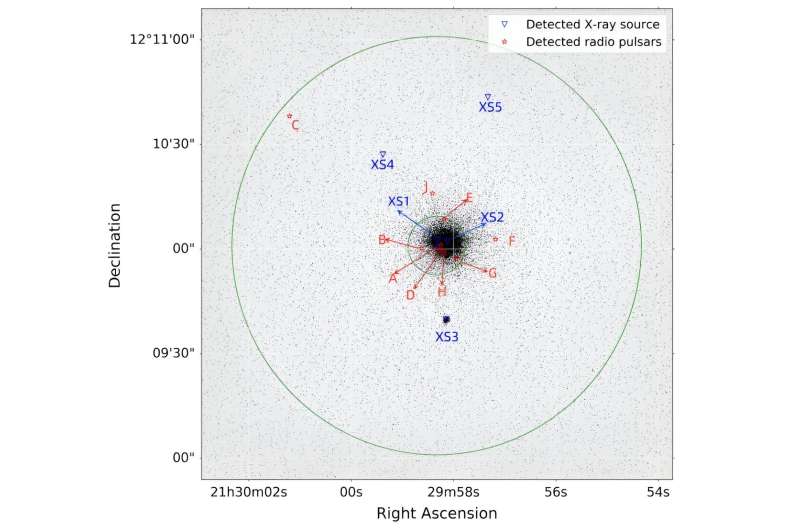December 20, 2023 report
This article has been reviewed according to Science X's editorial process and policies. Editors have highlighted the following attributes while ensuring the content's credibility:
fact-checked
preprint
trusted source
proofread
FAST detects three new pulsars in an old globular cluster

Using China's Five-hundred-meter Aperture Spherical radio Telescope (FAST), astronomers have discovered three new pulsars in an old Galactic globular cluster known as Messier 15. Two of them turned out to be long-period pulsars, while the remaining one spins so rapidly that it was classified as a millisecond pulsar. The finding was reported in a paper published Dec. 11 on the pre-print server arXiv.
Pulsars are highly magnetized, rotating neutron stars emitting a beam of electromagnetic radiation. The most rapidly rotating pulsars, with rotation periods below 30 milliseconds, are known as millisecond pulsars (MSPs). Astronomers assume that they are formed in binary systems when the initially more massive component turns into a neutron star that is then spun up due to accretion of matter from the secondary star.
Located some 35,700 light years away from the Earth, Messier 15 (also known as NGC 7078) is a core-collapsed GC with a radius of about 88 light years and an estimated mass of 560,000 solar masses. It is one of the oldest (about 12 billion years old) and most metal-poor Galactic GCs (with a metallicity of approximately −2.25), and one of the most densely packed GCs in our galaxy.
Previous observations of Messier 15 have detected nine pulsars and the first one was identified in 1989. According to simulations, Messier 15 is possibly one of the GCs with the highest number of pulsars. That is why a team of astronomers led by Yuxiao Wu of the Chongqing University of Posts and Telecommunications in China, decided to conduct a pulsar search in this cluster using FAST.
The newfound pulsars received the designations PSR J2129+1210J, PSR J2129+1210K and PSR J2129+1210L. The observations found that PSR J2129+1210J is an MSP, while the other two are long-period pulsars.
According to the study, PSR J2129+1210J is an isolated pulsar with a spin period of approximately 11.84 milliseconds and its dispersion measure was calculated to be 66.68 pc/cm3. When it comes to PSR J2129+1210K, it has a spin period of about 1.93 seconds and a dispersion measure of 68.01 pc/csm3.
With a spin period of 3.96 seconds, PSR J2129+1210L is the longest spinning pulsar in a GC known to date. The dispersion measure of this pulsar was found to be approximately 67.1 pc/cm3.
The researchers noted that the precise position of PSR J2129+1210K and PSR J2129+1210L remains unknown, but they are most likely not too far away from the core of Messier 15. Therefore, further observations are required in order to find their exact location, which will help to determine whether they are young or recycled pulsars.
More information: Yuxiao Wu et al, Three Pulsars Discovered in Globular Cluster M15 (NGC 7078) with FAST, arXiv (2023). DOI: 10.48550/arxiv.2312.06067
Journal information: arXiv
© 2023 Science X Network





















